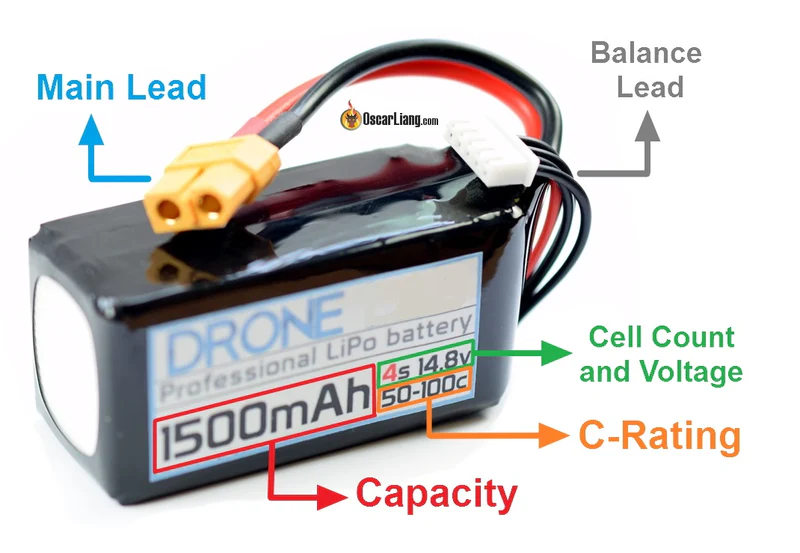LiPo, or Lithium-Ion Polymer Batteries, represent a significant technological leap. These high-performance energy sources find applications in an array of devices such as mobile gadgets, radio-controlled vehicles, electric cars, robotics, and many more. Due to the exceptional energy density, they deliver more power per unit of weight compared to other battery types.
Although LiPo batteries initially seem pricier, their cost-effectiveness becomes evident when considering the power they offer and the weight they save. However, with all those benefits come a handful of risks that demand careful handling. You must also adhere to specific guidelines for charging, discharging, storage, and disposal. If not, it can lead to performance issues, reduced battery lifespan, or even hazardous incidents like fire or explosion.
Nevertheless, when managed correctly, 11.1v LiPo batteries prove safe and enable the creation of projects otherwise unattainable.
Understanding 11.1v LiPo Batteries
11.1v LiPo batteries, a short-form for Lithium Polymer batteries, are rechargeable power sources. These are common in a wide range of applications, including RC vehicles, drones, and portable electronics. The high energy-to-weight ratio makes them ideal for devices that require a compact and lightweight power source.
How Do 11.1v LiPo Batteries Differ?
Unlike traditional nickel-based batteries, a LiPo 4s battery utilises a lithium-ion polymer electrolyte. It allows for higher energy density and faster discharge rates. However, this also makes them more sensitive to mishandling. Thus, special care is required during charging, storage, and usage.
Risks Associated with 11.1v LiPo Batteries
Though there is enough efficiency and more power, the Lipo batteries come with their contingencies that need to be taken care of. Below are a few issues that may creep with the battery:
Fire and Explosion Hazards
One of the primary risks associated with 11.1v LiPo batteries is the potential for fire and explosion if mishandled or improperly charged. Due to their high energy density, LiPo batteries have a chance of catching fire if punctured, overcharged, or exposed to extreme temperatures.
Chemical Leakage
Another concern with LiPo batteries is the risk of chemical leakage. It can occur if the battery is damaged or subjected to excessive stress. The electrolyte inside the battery is highly flammable and can cause burns or damage to surrounding materials if leaked.
Overcharging and Discharging Risks
Overcharging or discharging LiPo batteries beyond their recommended limits can lead to permanent damage, reduced performance, or even catastrophic failure. It’s essential to use a compatible charger and monitor the battery’s voltage during charging to prevent overcharging.
7 Essential Tips for Safe Handling
Proper Storage
Store LiPo batteries in a cool, dry place away from direct sunlight and flammable materials. You can use a fireproof LiPo battery bag or container to contain any potential fire or explosion.
Charging Precautions
Always use a LiPo battery charger specifically designed for LiPo batteries and follow the manufacturer’s instructions carefully. Never leave batteries unattended while charging, and avoid overcharging or charging at high temperatures.
Avoiding Physical Damage
Handle LiPo batteries with care and avoid dropping or crushing them, as this can cause internal damage and increase the risk of fire or explosion. Inspect batteries regularly for signs of swelling, leakage, or damage, and replace any damaged batteries immediately.
Monitoring Temperature
Keep an eye on the temperature of a LiPo 4s battery during charging, usage, and storage. Avoid exposing them to extreme heat or cold, as this can affect their performance and safety.
Using Compatible Equipment
Ensure that the devices and accessories used with LiPo batteries are compatible and properly rated for their voltage and discharge rates. Using incompatible equipment can lead to damage or failure of the battery and device.
Handling During Transportation
When transporting LiPo batteries, always use a fireproof LiPo battery bag or case to prevent damage or accidental activation. You must also secure the batteries to prevent movement or damage during transit and avoid exposing them to extreme temperatures or humidity.
Regular Maintenance and Inspection
Perform regular maintenance and inspection of LiPo batteries to ensure they are in good condition. You can do so by checking for signs of swelling, leakage, or damage and replacing any damaged batteries immediately. Also, old or damaged batteries must be disposed of properly according to local regulations.
Emergency Procedures
What to do in Case of Battery Damage?
If a LiPo battery is damaged or shows signs of swelling, leakage, or overheating, remove it from the device and place it in a fireproof container or LiPo battery bag. You must also not attempt to charge or use a damaged battery and dispose of it properly.
Steps to Take in Case of Fire or Explosion
In the event of a fire or explosion involving an 11.1v LiPo battery, evacuate the area immediately and contact emergency services. Use a fire extinguisher rated for lithium-ion fires if available, and avoid breathing in fumes from burning batteries.
To Sum Up
Safe handling of 11.1v LiPo batteries is essential to prevent accidents and ensure optimal performance. By following the seven essential tips outlined above and being vigilant about monitoring and maintenance, users can enjoy the benefits of LiPo batteries without compromising safety. Remember, safety always comes first when dealing with high-energy devices like LiPo batteries.
Power your adventures with RC Battery, the ultimate choice for reliable performance and unmatched durability. Engineered to deliver maximum power and endurance, we are trusted by hobbyists and professionals alike. Whether you’re racing at top speeds or soaring through the skies, trust us to keep you going strong. Elevate your RC experience with the power of RC Battery today.




